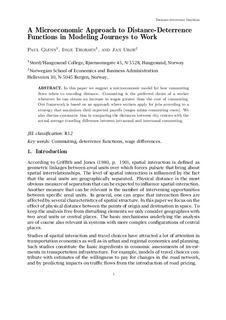| dc.contributor.author | Glenn, Paul | |
| dc.contributor.author | Thorsen, Inge | |
| dc.contributor.author | Ubøe, Jan | |
| dc.date.accessioned | 2006-07-13T18:05:21Z | |
| dc.date.available | 2006-07-13T18:05:21Z | |
| dc.date.issued | 2001 | |
| dc.identifier.issn | 1500-4066 | |
| dc.identifier.uri | http://hdl.handle.net/11250/163671 | |
| dc.description.abstract | In this paper we suggest a microeconomic model for how commuting flows relate to traveling distance. Commuting is the preferred choice of a worker whenever he can obtain an increase in wages greater than the cost of commuting. Our framework is based on an approach where workers apply for jobs according to a strategy that maximizes their expected payoffs (wages minus commuting costs). We also discuss systematic bias in comparing the distances between city centers with the actual average traveling difference between intrazonal and interzonal commuting. | en |
| dc.format.extent | 502429 bytes | |
| dc.format.mimetype | application/pdf | |
| dc.language.iso | eng | en |
| dc.publisher | Norwegian School of Economics and Business Administration. Department of Finance and Management Science | en |
| dc.relation.ispartofseries | Discussion paper | en |
| dc.relation.ispartofseries | 2001:12 | en |
| dc.subject | commuting | en |
| dc.subject | deterrence functions | en |
| dc.subject | wage differences | en |
| dc.title | A microeconomic approach to distance-deterrence functions in modeling journeys to work | en |
| dc.type | Working paper | en |
